

| Lecture Schedule of 2014 CTEQ Summer School | |||
| (click to download PDF file) |
|||
| Date | Time | Lecture | Lecturer |
| 9-Jul | 9:00-10:00 | Introduction to Parton Model and Perturbative QCD | Soper |
| 10:00-10:30 | Coffee Break | ||
| 10:30-11:30 | Introduction to Parton Model and Perturbative QCD | Soper | |
| 11:45-14:00 | Lunch | ||
| 14:00-15:00 | Deep Inelastic Scattering | Pumplin | |
| 15:00-15:30 | Coffee Break | ||
| 15:30-16:30 | Heavy Quark I | Zack | |
| 18:30-19:30 | Dinner | ||
| 19:30-22:30 | Recitation | ||
| 10-Jul | 9:00-10:00 | Introduction to Parton Model and Perturbative QCD | Soper |
| 10:00-10:30 | Coffee Break | ||
| 10:30-11:30 | Introduction to Parton Model and Perturbative QCD | Soper | |
| 11:45-14:00 | Lunch | ||
| 14:00-15:00 | Deep Inelastic Scattering | Pumplin | |
| 15:00-15:30 | Coffee Break | ||
| 15:30-16:30 | Heavy Quark II | Yang | |
| 18:30-19:30 | Dinner | ||
| 19:30-22:30 | Recitation | ||
| 11-Jul | 9:00-10:00 | Introduction to Jets | Li |
| 10:00-10:30 | Coffee Break | ||
| 10:30-11:30 | Neutrino Theory | ||
| 11:45-14:00 | Lunch | ||
| 14:00-15:00 | Vector Bosons / Direct Photons | Qiu | |
| 15:00-15:30 | Coffee Break | ||
| 15:30-16:30 | Parton Distribution Functions | Yuan | |
| 18:30-19:30 | Dinner | ||
| 19:30-22:30 | Recitation | ||
| 12-Jul | 9:00-10:00 | Jet substructure | Li |
| 10:00-10:30 | Coffee Break | ||
| 10:30-11:30 | Neutrino Experiment | Cao | |
| 11:45-14:00 | Lunch | ||
| 14:00-15:00 | Vector Bosons / Direct Photons | Qiu | |
| 15:00-15:30 | Coffee Break | ||
| 15:30-16:30 | Parton Distribution Functions | Yuan | |
| 18:30-19:30 | Dinner | ||
| 19:30-22:30 | Recitation | ||
| 13-Jul | Free day | ||
| 14-Jul | 9:00-10:00 | High Intensity Muon & Kaon | Kuno |
| 10:00-10:30 | Coffee Break | ||
| 10:30-11:30 | Monte Carlo Introduction | Schoenherr | |
| 11:45-14:00 | Lunch | ||
| 14:00-15:00 | Monte Carlo Matching | Prestel | |
| 15:00-15:30 | Coffee Break | ||
| 15:30-17:30 | Monte Carlo Tutorial | MCnet | |
| 18:30-19:30 | Dinner | ||
| 19:30-22:30 | Recitation | ||
| 15-Jul | 9:00-10:00 | High Intensity Muon & Kaon | Kuno |
| 10:00-10:30 | Coffee Break | ||
| 10:30-11:30 | Monte Carlo Introduction | Schoenherr | |
| 11:45-14:00 | Lunch | ||
| 14:00-15:00 | Monte Carlo Matching | Prestel | |
| 15:00-15:30 | Coffee Break | ||
| 15:30-17:30 | Monte Carlo Tutorial | MCnet | |
| 18:30-19:30 | Dinner | ||
| 19:30-22:30 | Recitation | ||
| 16-Jul | 9:00-10:00 | Experimental Results of SM Precision | Kotwal |
| 10:00-10:30 | Coffee Break | ||
| 10:30-11:30 | Experimental Results of Heavy Quarks | Chen | |
| 11:45-14:00 | Lunch | ||
| 14:00-15:00 | Higgs Physics | Yuan | |
| 15:00-15:30 | Coffee Break | ||
| 15:30-16:30 | SM and Beyond | Tobe | |
| 18:30-19:30 | Dinner | ||
| 19:30-22:30 | Recitation | ||
| 17-Jul | 9:00-10:00 | Experimental Results of Higgs Boson | Korytov |
| 10:00-10:30 | Coffee Break | ||
| 10:30-11:30 | Experimental Results of SUSY and BSM | Su | |
| 11:45-14:00 | Lunch | ||
| 14:00-15:00 | TMD Parton Distribution Functions | Ma | |
| 15:00-15:15 | Coffee Break | ||
| 15:15-16:15 | SM and Beyond | Tobe | |
| 16:15-16:30 | Break | ||
| 16:30-17:30 | Low Energy Spectroscopy | Shen | |
| 18:30-19:30 | Dinner | ||
| 19:30-22:30 | Recitation | ||
ARRIVAL INFORMATION & Schedule
PDF MAP OF KEY LOCATIONS: (under construction)
Tuesday July 8:
All day: Arrive, Check into Hotel, Pick up key
7-9pm: Dinner in Yiyuan restaurant (on the second floor of No. 2 Building)
Wednesday July 9:
7:30-8:45am: Breakfast in Yiyuan restaurant (on the second floor of No. 2 Building)
9:00am: Lectures being in Oversea Exchanging Center No. 2 Conference room
(We will give you a registration packet with full info at the lecture)
CONTACT INFORMATION
The contacts for the school are:
Ms. Rui Li
Tel: (+86)10-62759322
Email: 0ec238i@pku.edu.cn
Emergency contact:
Qing-Hong Cao
Tel:(+86)10-62762606
Cell: 13021255992
Email: qinghongcao@pku.edu.cn
RESTAURANTS ON CAMPUS
Most cafeteria on campus requires student IDs. You can still use cash in a few restaurants marked by red numbers. Yiyuan Restaurant (3) and Heyuan Restaurant (5), located in Global Village No.2 and No.5 building, are highly recommended. Please find other choices nearby PKU in the booklet.
(click on the map for high resolution PDF file)
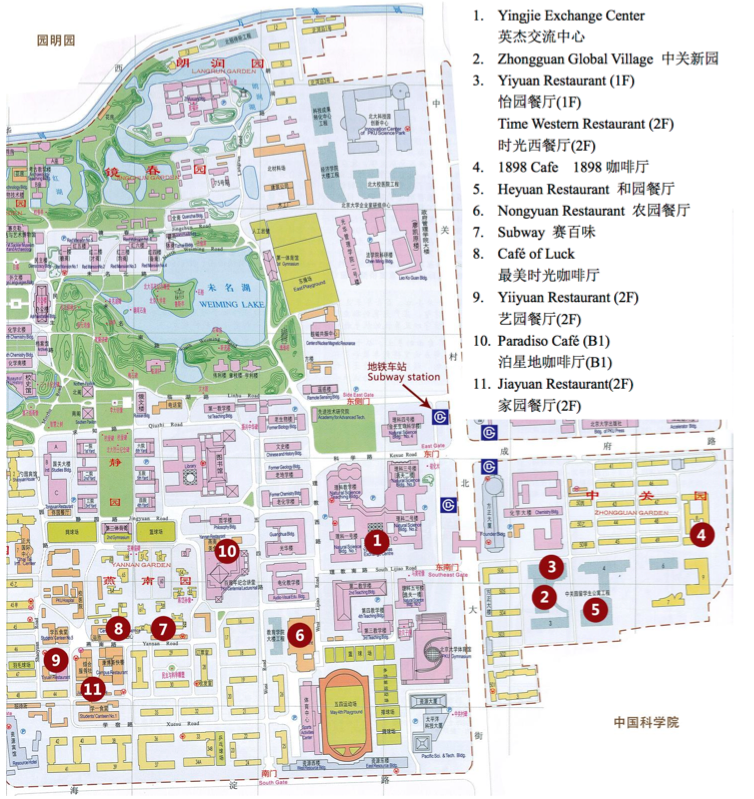
LECTURE ROOM LOCATION
Moon light Hall of Yingjie Exchange Center, Peking University
北京大学英杰交流中心月光厅
From Hotel to Lecture room (click for high resolution map)


HOTEL AND UNIVERSITY INFORMATION
Hotel Address:
Zhongguanyuan Global Village PKU
No. 126, Zhongguancun North Street,
Haidian District, Beijing, 100871,
China
Tel: (+86) 10-62752288
Fax: (+86) 10-62752289
Email: pkugv@pku.edu.cn
Website: http://www.pkugv.com/english/index.asp
Location Map:
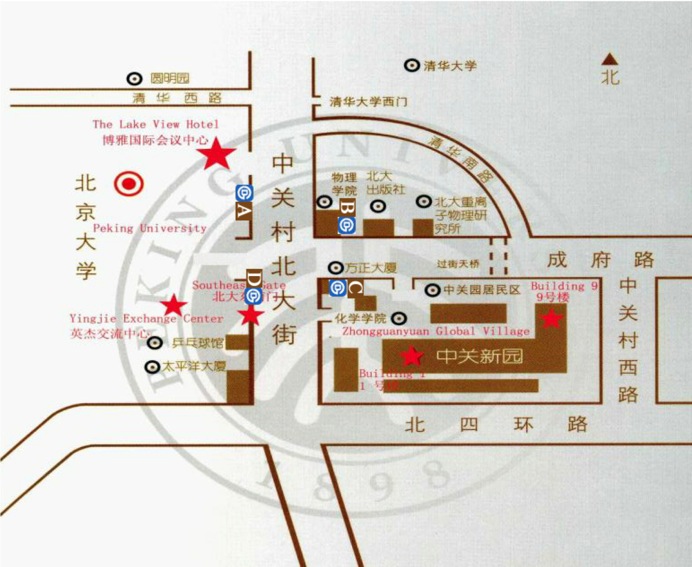
TRAVEL INFORMATION
(Getting from airport to hotel)
Please bring some Chinese currency or exchange money at the banks at the airport since the taxi and subway accept Chinese cash only.
Taxi:
You are recommended to take a taxi which You are recommended to take a taxi which can be easily found from the taxi station outside the Beijing International Capital Airport waiting hall. Please show the bilingual note (attachment) to the taxi driver if you do not speak the language. It takes you about CNY¥130 ($20) from the airport to the hotels.
(click on the note for high resolution PDF file)
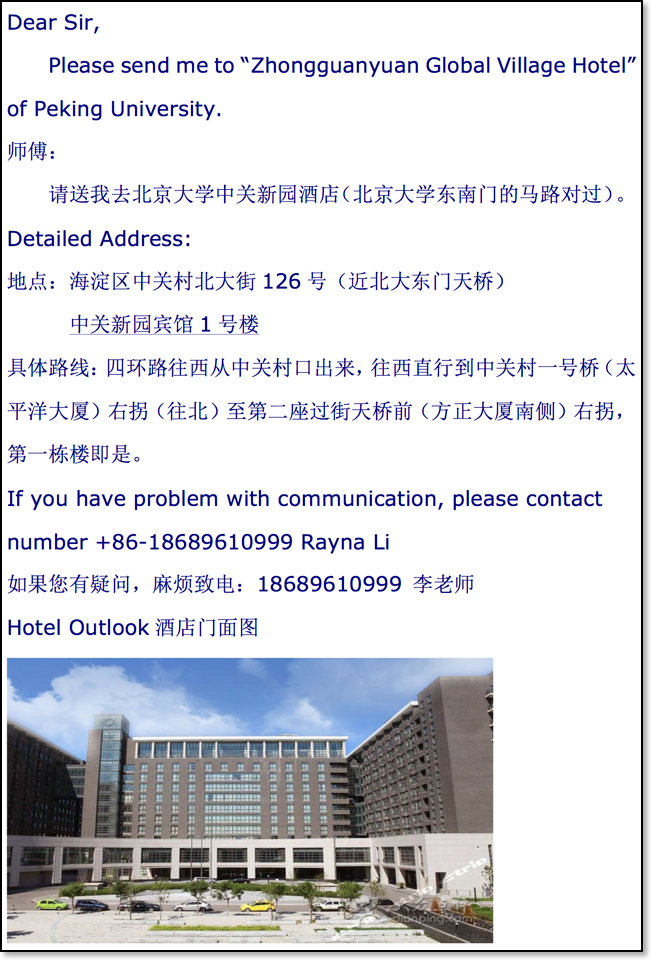
Subway:
If you prefer public transportation, you can take the Airport Express, exchange to Subway line 10 at Sanyuanqiao Station (三元桥), and then exchange to Subway line 4 at Haidianhuangzhuang Station (海淀黄庄), and get off at East Gate of Peking University Station (北京大学东门). The hotels are then within walking distance (To Zhongguanyuan Global Village,please exit from C; To Conference Venue, please exit from D).
(Click on the map for high resolution version)
subway
Handbook for 2014 CTEQ summer school
click to download PDF file![]() Beijing_handbook.pdf
Beijing_handbook.pdf
Dear friends,
Welcome to Peking University!
In order to make your stay enjoyable and convenient, please be aware of the following notes:
Hotel
You will be accommodated in Building #1 of Zhongguanyuan Global Village (中关新园1号楼) near campus.
Phone call (which is made in the hotel room)
1. If you need to contact classmates inside the Hotel, please dial the 5-digit room number directly, phone calls between hotel rooms are free.
2. Local calls (fixed-line phone or mobile phone within Beijing), please dial '0' and then the number. Duration of local calls for less than 2 hours each day will be free.
3. Domestic long distance calls (Outside of Beijing but within China), please dial '00' and then the number. (0.77RMB/minute)
4. International long distance calls, please dial '000' and then the number. (8.8RMB/minute)
5. Comparing to making phone calls in the hotel, it is much cheaper to use IP cards. And these cards can be bought in campus.
Dining
Breakfast is available on the second Floor (6:30-9:30am) in Building #1 of Zhongguanyuan Global Village.
Laundry(charged service)
Cleaning service is available in your hotel. You could put the clothes in the laundry bag in your room and give it to the hotel staff.
Internet
Free wire internet access is available in your hotel room.
Money Exchange
On the way to Peking University from the hotel stand two banks: Bank of Beijing (北京银行) & China Minsheng Bank (中国民生银行). Please bring your passport when you exchange the money. If you would like to use credit cards to withdraw cash (RMB)from ATM, check if there is a sign that is the same with the one on your card.
Lectures
All day lectures will be given in Moonlight Hall of Yingjie Exchange Centre (英杰交流中心月光厅).
(Shown on the map labeled as 1)
All night cap will be held in the Lakeview Hall of Zhongguanyuan Global Village
(Shown on the map labeled as 2)
(click on the map to see details)
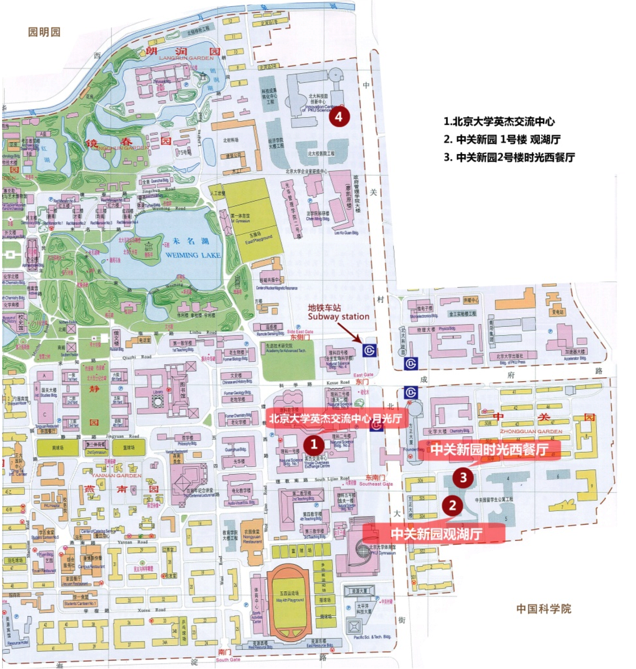
Emergency Contacts
Zhongguanyuan Global Village (中关新园)
Tel: 62752288
Ms. Rayna Li
Tel (Office):62759840; Cell:18689610999
Enjoy your time in Beijing!
If you have any questions or problems, please feel free to contact us.
Dining Directions
On Campus
Lunch, Foods in most cafeterias on campus require campus card. According to the new regulation of Peking University, cash can be used directly only at the 2nd floor of YiYuan (艺园) and the 3rd floor of Nongyuan (农园). Also there are some mini-mart and shops in campus, such as SUBWAY near Boshi Mini-mart (博实超市),where you can buy food directly.
Dinner, buffet at Times Restaurant in the Zhongguanyuan Global Village (Shown on the map labeled as 3)
Near Campus
Restaurants near campus are neat, cheap and tasty. However, the service may not be excellent, and sometimes they are crowded. You may have difficulty in ordering if you do not speak Chinese. Still, it is a good choice to have a quick lunch there.
There are some restaurants along the road opposite the south gate of PKU, and most of them serve Chinese food. Among them are DaiJia (傣家云南米线 )in Yunnan Style, Yipinxiaolong (一品小笼)famous of beam meat bun, etc. (Shown on the restaurant map labeled as A)
Go out of the residential subdistrict in which the hotel stands, go east along the Chengfu Road成府路about 500meters to LanQiYing area(蓝旗营), you will find some Chinese restaurants serving Yunnan food, Sichuan food, hot-pots, porridge and bar etc. (Shown on the restaurant map labeled as B)
If you find the above not attractive enough, you can go a little farther. Walk along the road towards east for about 500-1000 meters to the area of WuDaoKou(五道口),dozens of restaurants in various styles will be within your sight. If you like to have a taste of family food, KFC (肯德基) and Pizza Hut (必胜客) can also be found there. There are also some coffee houses and Korean restaurants. Go and have a try; and they will not fail you. (Shown on the restaurant map labeled as C)
Local Restaurants
If you have both time and interest to venture into the city, the following restaurants are recommended. More expensive as they might be, you will find them worth going.
Chinese Food
Quanjude Roast Duck Restaurant
全聚德烤鸭店(清华店)
As the most famous duck restaurant in the city, Quanjude has been serving duck since 1864.
Address:1st floor, Technological Building A, Tsinghua Technological Garden of East Road of Zhongguancun (South Gate of Tsinghua University)
海淀区中关村东路1号院清华科技园科技大厦A座1楼(清华大学南门东)
Tel: 8215001 882151015 (Reservation advised)
Donglaishun Hot-pot Restaurant
东来顺火锅店
Address: #198, Wangfujing Street 东城区王府井大街198号
Tel: 65139661 (Reservation advised)
Laoshe Tea House
老舍茶馆
You can enjoy traditional Chinese performing arts like magic shows, puppetry, “cross talk”, and Peking Opera at 7:50pm-9:30pm every evening as well as delicious local snacks.
Address: 3 Qianmen Xi Da Jie, Xuanwu District宣武区前门西大街正阳市场三号楼
Tel: 63036830(Reservation required)
Lvseloulan Xinjiang Halal Restaurant
绿色楼兰
Address: Xibeiwang, Haidian District (Inside the Institute of Medicinal Plant Development) 海淀区西北旺药用植物研究院内
Tel: 62817506
Other Food
Banana Leaf Thailand Cuisine Restaurant
蕉叶
Address: South Side, B Enter, Zhongguancun Shopping Center, Haidian District
海淀区中关村大街15号中关村广场购物中心B区入口南侧
Tel: 59863666
Moscow Restaurant
莫斯科餐厅
Address: #135, Xizhimenwai Da Jie, Xicheng District 西城区西直门外北京展览馆院内
Tel: 68354454/68353713(Reservation advised)
Note
Ordering food is not a problem for foreigners at big restaurants because the waiters speak English and the menu is in English. But in small restaurants, it may be a difficult job. Some of them will provide you with the pictures of the dishes, but when they do not, an easiest way is to ask the restaurant to make recommendations of their own delicacies, or let them point to your phrasebook to tell you the ingredients of the dishes, and a third way is to point to what the others are eating. It is suggested that you ask for a detailed bill and keep the receipt.
(Restaurant map, click on the map to see details)

Useful Chinese Notes
Address
Peking University 北京大学
Capital International Airport 首都国际机场
Bldg. #9 Zhongguanyuan Global Village, PKU 北京大学中关新园9号楼 (海淀区中关村北大街126号, 沿中关村北大街,由方正大厦南侧路口右转直行到头,左边的楼既是)
Palace Museum 故宫
Summer Palace 颐和园
Tian’ anmen Square 天安门广场
Silk Street 秀水街
Cultural Street 琉璃厂
Wang Fujing Street 王府井大街
Temple of Heaven 天坛
Pearl Market 红桥市场
The Great Wall 慕田峪长城
Lama Temple 雍和宫
Chao Yang Theater 朝阳剧场
798 Art District 798艺术区
Bar streets: The bar street beside lake (Houhai Bar Street) 后海酒吧街
The bar street near the Workers’ Stadium (Gongti Bar Street) 工体酒吧街
Menu:
Pork 猪肉 (zhu rou)
Beef 牛肉 (niu rou)
Lamb羊肉 (yang rou)
Chicken鸡肉 (ji rou)
Rice 米饭 (mi fan)
Noodle 面条 (mian tiao)
Dumpling 饺子 (jiao zi)
Vegetables 蔬菜 (shu cai)
I am vegetarian, no meat. 我是素食者,不吃肉
Coke可乐
Pepsi 百事可乐
Diet Coke 健怡可乐
Sprite 雪碧
Useful Expressions:
1. Please take me to… 请送我到…(Qing song wo dao)
2. I would like to buy…我想买…(Wo xiang mai…)
3. How much is it? 多少钱?(Duo shao qian)
4. Can I use the telephone please?
我能用一下电话吗?(Wo neng yong yi xia dian hua ma?)
5. Good morning. 早上好(Zao shang hao)
6. Goodbye. 再见 (Zai jian)
7. Thank you. 谢谢(Xie xie)
8. Sorry. 对不起 (Dui bu qi)
Hospital
The pharmacy and the university hospital are on campus, which are near your hotel (shown on the map). If you do feel uncomfortable, please contact us, go to the university hospital or contact International SOS (SOS国际救援中心,Tel:64629100).
Transportation
Taxi: The price is ¥2.3/km. This price would be 50% higher after 15 km or during the nighttime (11pm-5am). The initial price will be ¥13 before 11pm, and it will be 20% up base on the initial price from 11pm to 5am. Standard fuel surcharge ¥1 is required when you taking a taxi. It’s suggested to keep the receipt in case you lose something in the car or have any complaint.
Subway: You can take subway Line 4, get off at the stop of East Gate of Peking University(北京大学东门站), and exit from C or D to get back to hotel.
Check Out
Please check out before 12:00pm. The check-out after 12:00pm will be charged another half day’s room rate.
DON’T
1. Don’t buy sword, katana, etc. Those can neither be mailed nor pass the security check of China Custom at the airport.
2. Don’t lose your room card. You would be charged ¥50 if you lose it.
3. Don’t drink directly from the faucet. Make sure that tap water is boiled before drinking. Bottles of pure/mineral water are available at mini-marts or shops on campus and in the hotel.
DO
1. Be careful of the food’s quality, and eat clean food. The food sold at the roadside may not be clean or fresh.
2. Drink enough water when you are outside in order to avoid sunstroke. Summer in Beijing is humidly hot and the sunlight is strong.
3. Go out accompanied by friends, especially at night.
4. Take care of your passport, valuables, and always place your bag in front of you especially when the street is crowded.
CTEQ 2014 Lecture notes
Focused Introductory Reviews:
Introduction to the Parton Model and Perturbative QCD (Soper): PDF (audio1&2, audio3&4)
Monte Carlo Introduction (Schoenherr): PDF1 (audio), PDF2 (audio)
Deeply Inelastic Scattering (Pumplin): PDF (audio1, audio2)
Higgs Boson Physics (Yuan): PDF (audio)
Vector Bosons / Direct Photons (Qiu): PDF1 (audio), PDF2 (audio)
Production and Structure of High Energy Jets (Li): PDF1 (audio), PDF2 (audio)
Heavy Quarks (Sullivan & Yang): Sullivan (audio), Yang (audio)
In-depth Analysis and Phenomenology
Monte Carlo Tutorial (Prestel & Schoenherr) Rivet, Preparation (audio)
Experimental Results of Higgs Boson (Korytov): PDF (audio)
Experimental Results of SM Physics (Kotwal): PDF (audio)
Experimental Results of Heavy Quark (Chen): PDF (audio)
Experimental Results of SUSY+BSM (Su): PDF (audio)
Parton Distribution Functions and Global Fits (Yuan): PDF1 (audio), PDF2 (audio)
Transverse Momentum Dependent PDFs (Ma): PDF (audio)
Neutrino Physics (TH: Xing ; EXP: Cao): Xing (audio), Cao (audio)
High Intensity Muon and Kaon (Kuno): PDF1 (audio), PDF2 (audio)
The Standard Model and Beyond (Tobe): PDF (audio1, audio2)
NLO Computation and Matching/Merging (Prestel): PDF1 (audio), PDF2 (audio)
Low Energy Spectroscopy (Shen): PDF (audio)
CTEQ 2013 Lecture notes
Focused Introductory Reviews:
Introduction to the Parton Model and Perturbative QCD (Owens) one, two, three, four
Monte Carlo Introduction (Gieseke) one, two
Deeply Inelastic Scattering (Radescu) one, two
Higgs Boson Physics (Reina) one-two
Vector Bosons / Direct Photons (Campbell) one, two
Production and Structure of High Energy Jets (Soper) one, two
Heavy Quarks (Leibovich) one, two
In-depth Analysis and Phenomenology:
Monte Carlo Tutorial (MC Net) note, day1, day2, day3, vboxinfo
Higgs at Hadron Colliders (LeCompte) one, two
QCD/EWK/Top/Searches at Hadron Colliders (Demers) one, two
PDFs and Global Fits (Accardi) one, two
Neutrino Physics (Naples) one, two
Intensity Frontier (Winter), one, two
The Standard Model and Beyond (Chivukula) one
NLO Computation and Matching/Merging (Krauss) one, two
The page is duplicated from MCnet page.
Prerequisites
This tutorial uses a virtual machine. Please install Oracle Virtual Box on your personal computer prior to the tutorial. Due to time constraints we cannot assist you with setting up software during the tutorial itself. If you have questions regarding installation, please ask them beforehand.
PKU server: Win or Mac
Please download the Linux version from official website.
Download
The virtual machine disk can be downloaded from here. For Windows use .zip format, for Linux/MacOS use .bz2. Unarchive the disk (e.g. using bunzip2 on Linux/MacOS).
PKU server: Win (CTEQ14.vdi.zip) or Mac (CTEQ14.vdi.bz2)
md5sum:
3a18dd4be78f118531f871741a3ed833 CTEQ14.vdi.bz2
350facf782ed10135d198b0e5a4969de CTEQ14.vdi.zip
Creating the Virtual Machine
Create a new machine with VirtualBox using the GUI. In the first step, VirtualBox will ask for the name of the machine and its OS. For the latter choose Linux -> Ubuntu. In the next step, set the size of the memory. About 1GB should be fine. In the last step, select the virtual disk. Choose 'Use an existing virtual hard drive file' and open the *.vdi file you just downloaded and extracted.
Before starting the virtual machine, enter its settings and increase the video RAM size to at least 48MB (Settings -> Display -> Video). If you have more than two processor cores on your host system, allow the VM to use two cores (Settings -> System -> Processor). You must enable hardware virtualization in your BIOS to do this!
Starting the Virtual Machine
We are booting a lightweight Linux, which you can customise.
The login name is student, the password is 2014.
The keyboard layout can be set using the 'Lxkeymap' program from the task bar, or using setxkbmap LC in the terminal, where LC is your language code (us, de,...).
Common tools which are installed include xterm, lxterminal, vi, emacs, gv, evince and firefox. If you need root privileges to install further programs of your choice, use sudo.
Running the tutorial
Instructions for the tutorial are found online and in the ~/tutorials/ folder of the virtual machine. There are two directories, intro/ and higgs/, corresponding to the tutorials on day one and two. The directories are again divided into sub-directories mg5_amc/ (day one only), pythia/ and sherpa/. On day one, please refer to the generator-specific instructions in these directories. On day two, please refer to the worksheets in the higgs/ folder.
PKU server: ![]() Day1.pdfand
Day1.pdfand![]() Day2.pdf
Day2.pdf
TOUR INFORMATION
A one day city excursion tours will be provided during the conference for a sightseeing of Beijing.
A. City Excursion
Line 1: The Great Wall
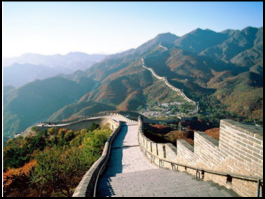
The Great Wall is 6350km long and was in China's feudal years a mammoth defense bulwark that serpentined its way across mountains and valleys in the northern part of the country. Construction of the Great Wall began in the 7th century BC. But it was Qinshihuang, the founding emperor of the first unifying dynasty Qin, who brought it to completion. Repeated extensions were done in later dynasties until the Ming. The 600-year-old Badaling Fortification in Yanqing County in northwest Beijing is representative of Ming sections of the Great Wall.
Line 2: Forbidden City
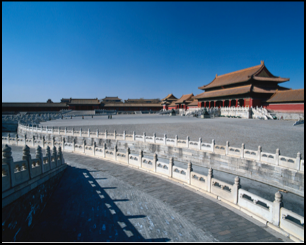
The Forbidden City, now known within China as the Palace Museum, occupies the central part of Beijing Municipality, and was the imperial palace of the Ming and Qing dynasties. Its construction began in 1406. Over the years after its completion, 24 emperors ruled the whole country from here for nearly 500 years. With many halls and pavilions, marble railings and steps, red walls and yellow tiles, the Forbidden City looks resplendent and magnificent. It occupies an area of over 720,000 square meters with 9,000 bays of halls and rooms.




| # | FirstName | LastName | CurrentOrganization |
| 1 | Didier | Alexandre | University of Birmingham |
| 2 | Abhiram Kaushik | Badrinarayanan | Indian Institute of Science |
| 3 | Shou-Shan | Bao | Shandong University |
| 4 | Qing-Hong | Cao | Peking University |
| 5 | Jun | Cao | Institute of High Energy, Chinese Academy of Sciences |
| 6 | Gu | Chen | Chongqing University |
| 7 | Shiyong | Chen | Central China Normal University |
| 8 | Wei | Chen | Central China Normal University |
| 9 | Shao-Long | Chen | Central China Normal University |
| 10 | Kai-Feng | Chen | National Taiwan University |
| 11 | Yujie | Chi | Peking University |
| 12 | Mireia | Crispin Ortuzar | University of Oxford |
| 13 | Manlin | Cui | Liaoning Normal University |
| 14 | Analu | Custodio | Universidade do Estado do Rio de Janeiro |
| 15 | Peter | Davison | University College London |
| 16 | Ran | Ding | Nankai University |
| 17 | Lipei | Du | Peking University |
| 18 | Xiaozhen | Du | Peking University |
| 19 | Hai-Bing | Fu | Chongqing University |
| 20 | Andrii | Gizhko | Deutsches Elektronen-Synchrotron |
| 21 | Bin | Gong | Institute of High Energy Physics, Chinese Academy of Sciences |
| 22 | Ti | Gong | Peking University |
| 23 | Xing-Dao | Guo | Nankai University |
| 24 | Shaun | Gupta | University of Oxford |
| 25 | Christian | Gutschow | University College London |
| 26 | Chengcheng | Han | Institute of Theoretical Physics, Chinese Academy of Sciences |
| 27 | Zhi-Long | Han | Nankai University |
| 28 | Tao | Han | University of Pittsburgh |
| 29 | Iain | Haughton | University of Manchester |
| 30 | Yayun | He | Central China Normal University |
| 31 | Tie-Jiun | Hou | Institute of Physics, Academia Sinica |
| 32 | Fa Peng | Huang | Peking University |
| 33 | Weicong | Huang | Institute of Theoretical Physics, Chinese Academy of Sciences |
| 34 | Yanqi | Huang | Peking University |
| 35 | Yin | Huang | Institute of Modern Physics, Chinese Academy of Sciences |
| 36 | Lina Milena | Huertas Guativa | Universidade do Estado do Rio de Janeiro |
| 37 | Julia | Iturbe | University of Manchester |
| 38 | Charles | Kalderon | University of Oxford |
| 39 | Stefan | Kofler | University of Graz |
| 40 | Nataliia | Kondrashova | Deutsches Elektronen-Synchrotron |
| 41 | Andrey | Korytov | University of Florida |
| 42 | Ashutosh | Kotwal | University of Duke |
| 43 | Yoshitaka | Kuno | Osaka University |
| 44 | Yu-Hong | Lei | Peking University |
| 45 | Hai Tao | Li | Peking University |
| 46 | Honglei | Li | Jinan University |
| 47 | Jinmian | Li | Institute of Theoretical Physics, Chinese Academy of Sciences |
| 48 | Shi Ang | Li | Peking University |
| 49 | Hairong | Li | Indiana University |
| 50 | Xingguo | Li | University of Manchester |
| 51 | Gang | Li | Peking University |
| 52 | Hsiang-nan | Li | Institute of Physics, Academia Sinica |
| 53 | Yandong | Liu | Peking University |
| 54 | Ze Long | Liu | Peking University |
| 55 | Xue-Wen | Liu | Nankai University |
| 56 | Tan | Luo | Central China Normal University |
| 57 | Oliver | Lupton | University of Oxford |
| 58 | Jian-Ping | Ma | Institute of Theoretical Physics, Chinese Academy of Sciences |
| 59 | Yingnan | Mao | Peking University |
| 60 | Huseyin | Masum | Xinjiang University |
| 61 | Bruce | Mellado | University of the Witwatersrand |
| 62 | Jorge | Morfin | Fermi Natioanl Laboratory |
| 63 | Volodymyr | Myronenko | Deutsches Elektronen-Synchrotron |
| 64 | Pavel | Nadolsky | Southern Methodist University |
| 65 | Cong | Pang | Liaoning Normal University |
| 66 | Dennis | Perepelitsa | Brookhaven National Laboratory |
| 67 | Luca | Pescatore | University of Birmingham |
| 68 | Mark | Pickering | University of Oxford |
| 69 | Stefan | Prestel | Lund University |
| 70 | Jonathan | Pumplin | Michigan State University |
| 71 | Yang | Qin | University of Manchester |
| 72 | Jian-Wei | Qiu | Brookhaven National Laboratory |
| 73 | Michaela | Queitsch-Maitland | University of Manchester |
| 74 | Reyimahan | Rexiding | Xinjiang University |
| 75 | Marek | Schoenherr | Durham University |
| 76 | Liang | Shang | Henan Normal University |
| 77 | Ding Yu | Shao | Peking University |
| 78 | Chen | Shen | Peking University |
| 79 | Xiaoyan | Shen | Institute of High Energy, Chinese Academy of Sciences |
| 80 | Sozha | Sohaily | S. B. University of Kermen |
| 81 | Davision | Soper | University of Oregon |
| 82 | Shufang | Su | University of Arizona |
| 83 | Zack | Sullivan | Illinois Institute of Technology |
| 84 | Chen | Sun | Virginia Tech Department of Physics |
| 85 | Yilei | Tang | Institute of Theoretical Physics, Chinese Academy of Sciences |
| 86 | Kazuhiro | Tobe | Nagoya University |
| 87 | Marco | Tresch | Physik-Insitut Universität Zürich |
| 88 | Nikos | Varelas | University of Illinois at Chicago |
| 89 | Sheng-Quan | Wang | Chongqing University |
| 90 | Xiao-Chuan | Wang | Institute of Theoretical Physics, Chinese Academy of Sciences |
| 91 | Wang | Peking University | |
| 92 | Yan | Wang | Peking University |
| 93 | Ying | Wang | Shandong University |
| 94 | Rong | Wang | Institute of Modern Physics, Chinese Academy of Sciences |
| 95 | Kuhan | Wang | McGill University |
| 96 | Haoran | Wang | Peking University |
| 97 | Yiwen | Wen | Peking University |
| 98 | Peiwen | Wu | Institute of Theoretical Physics, Chinese Academy of Sciences |
| 99 | Yongcheng | Wu | Tsinghua University |
| 100 | Ruiqing | Xiao | Tsinghua University |
| 101 | Zhi-Zhong | Institute of High Energy, Chinese Academy of Sciences | |
| 102 | Tao | Xu | Zhejiang University |
| 103 | Bin | Yan | Peking University |
| 104 | Qishu | Yan | University of Chinese Academy of Sciences |
| 105 | Daneng | Yang | Peking University |
| 106 | Shuo | Yang | Dalian University |
| 107 | Lilin | Yang | Peking University |
| 108 | Fu-Sheng | Yu | Lanzhou University |
| 109 | C.-P. | Yuan | Michigan State University |
| 110 | Yong Chuan | Zhan | Peking University |
| 111 | Liang-Liang | Zhang | Zhejiang University |
| 112 | Yang | Zhang | Henan Normal University |
| 113 | Cheng | Zhang | Central China Normal University |
| 114 | Dongming | Zhang | Peking University |
| 115 | Chen | Zhang | Peking University |
| 116 | Baiwei | Zhang | Central China Normal University |
| 117 | Xiaoran | Zhao | University of Chinese Academy of Sciences |
| 118 | Yong | Zhao | University of Maryland |
| 119 | Shiyu | Zhao | Liaoning Normal University |
| 120 | Yaofu | Zhou | Johns Hopkins University |
| 121 | Shou-Hua | Zhu | Peking University |




